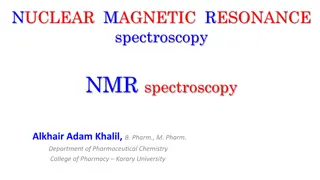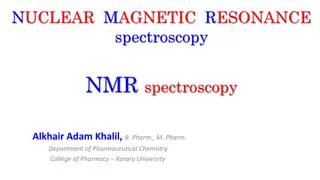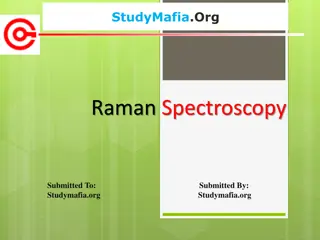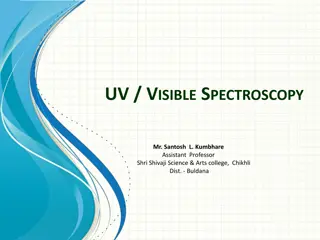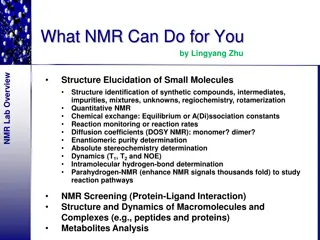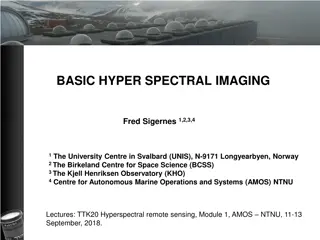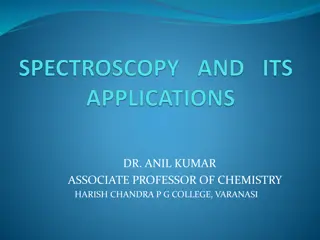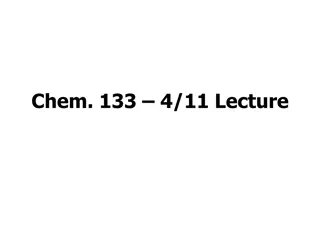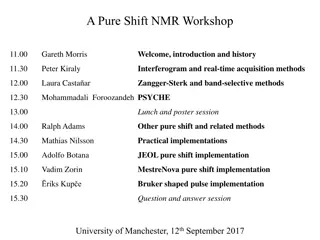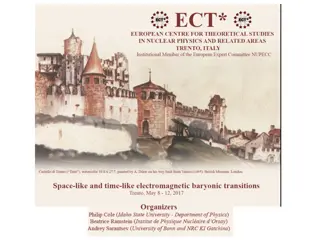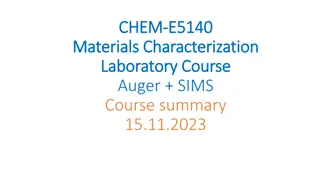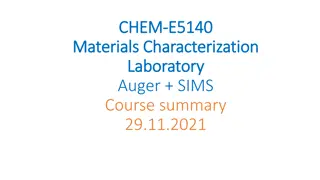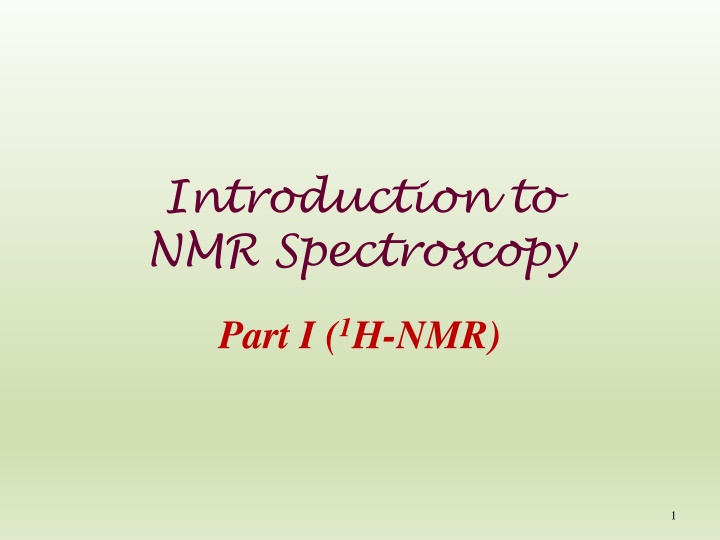
NMR Spectroscopy: A Comprehensive Overview
Discover the principles and applications of Nuclear Magnetic Resonance (NMR) spectroscopy, a powerful technique for analyzing molecular structures based on magnetic interactions. Learn about the physical background, resonance phenomenon, effective magnetic fields, and NMR-active nuclei.
Download Presentation

Please find below an Image/Link to download the presentation.
The content on the website is provided AS IS for your information and personal use only. It may not be sold, licensed, or shared on other websites without obtaining consent from the author. If you encounter any issues during the download, it is possible that the publisher has removed the file from their server.
You are allowed to download the files provided on this website for personal or commercial use, subject to the condition that they are used lawfully. All files are the property of their respective owners.
The content on the website is provided AS IS for your information and personal use only. It may not be sold, licensed, or shared on other websites without obtaining consent from the author.
E N D
Presentation Transcript
Introduction to NMR Spectroscopy Part I (1H-NMR) 1
Introduction Nuclear Magnetic Resonance (NMR) Spectroscopy is a technique that is used to determine the type, number and relative positions of certain atoms in a molecule. Originally discovered by Felix Bloch and Edward Purcell in 1946 (both shared the Nobel Prize in Physics in 1952 for their pioneering work), it has seen a significant increase in popularity with the development of FT-NMR spectrometers. 2
Physical Background of NMR Spectroscopy I Nuclei, which are moving and charged particles, generate a magnetic field when doing so. The precession of a nucleus with a nonzero magnetic momentum can be described using a vector model. Generally, the precession is a quantized phenomenon: The magnetic moment m is either aligned (mI= ) or opposed (mI= - ) (for a nucleus with I= ) to the applied field, resulting into two energy states. The magnetic moment m assumes (2*I+1) states for a nucleus in an applied field (i.e., D: I= 1, mI= -1, 0, 1). Energy mI= - E= f( Bo)= h mI= + Increased magnetic field Bo 3
Physical Background of NMR Spectroscopy II A resonance phenomenon occurs when the aligned nuclei interact with the applied field and are forced to change their spin orientation. The energy, which is absorbed, is equal to energy difference E between the two spin states. This resonance energy is about 10-6 kJ/mol (the radio-frequency). 60 MHz 600 MHz 0.80 1.10 1.00 0.70 0.90 0.60 0.80 0.70 0.50 0.60 0.40 0.50 0.30 0.40 0.30 0.20 0.20 0.10 0.10 0.00 0.00 3.5 3.0 2.5 2.0 1.5 1.0 0.5 0.0 3.5 3.0 2.5 2.0 1.5 1.0 0.5 0.0 The stronger the applied field, the greater energy difference between the spin states ( E) becomes, which allows distinguishing even between very similar atoms. The NMR spectrometers with stronger magnetic fields provide better resolution. The NMR experiment itself becomes more sensitive as well because saturation is less of a problem due to a more uneven population of the energy levels. 4
Physical Background of NMR Spectroscopy III The effective magnetic field is a result of the applied magnetic field and the changes that are induced by the environment: Heff= Ho Ho The changes are often summarized into a shielding constant, . = o B = dia+ para+ neighbor+ medium 1 ( ) 2 The larger the shielding constant and the smaller the effective field, the higher the applied field has to be in order for the nucleus to resonate at constant frequency. If a constant magnetic field is applied, the resonance frequency will decrease with increasing shielding. In 1H-NMR spectroscopy, the diamagnetic and neighboring effects are the most important contributions because only s-orbitals are important. In 13C-NMR, the paramagnetic term becomes more significant because of the larger contributions from the p-electrons resulting in a larger shift range. 5
NMR Active Nuclei Most elements possess at least one NMR active nucleus, but many of them several (i.e.,115Sn, 117Sn and 119Sn, 95Mo and 97Mo, etc.). However, in order for an atom to be NMR active, the spin quantum number (I) must not equal zero. If the proton and neutron number are even, the spin quantum number will be zero. Nuclei like 12C, 16O or 32S will not be observable, but 13C, 17O and 33S are NMR active nuclei. Nuclei with a spin quantum number larger than I= often show broad lines because of their quadrupole moment. There is a significant difference in abundance in these NMR active nuclei and the sensitivity of these experiments differs quite a bit as well. Nucleus Spin Quantum Number, I 1 0 1 0 5 2 Natural Abundance 99.985 % 0.015 % trace 98.89 % 1.11 % 99.6 % 0.37 % 99.76 % 0.04 % 100 % 100 % Magnetogyric ratio, g (107 rad T-1s-1) 26.7519 4.1066 28.535 NMR Active YES YES YES NO YES YES YES NO YES YES YES Protons Neutrons Standard 1H 2H 3H 12C 13C 14N 15N 16O 17O 19F 31P 1 1 1 6 6 7 7 8 8 9 0 1 2 6 7 7 8 8 9 10 16 (CH3)4Si (CD3)4Si TMS-T1 6.7283 1.934 -2.712 (CH3)4Si CH3NO2 CH3NO2, NH3(l) -3.62808 25.181 10.841 D2O CCl3F 85 % H3PO4 15 6
Information from the NMR Spectrum I Symmetry If there are fewer signals than atoms of a particular kind, there has to be symmetry in the molecule. Even for simple groups this assumes that there is free rotation about -bonds, which will strictly speaking only be true when the temperature is high enough to provide enough energy for this process. 7
Information from the NMR Spectrum II Multiplet From coupled spectra i.e., 1H-NMR spectra, it is often possible to obtain information about the neighboring atoms based on the splitting of the signal. This holds especially true for proton spectra, where the multiplet structure reveals how many hydrogen neighbors a given CHx- function (x=1-3) has. Most of the 13C-NMR spectra are obtained as proton-decoupled spectra (13C{1H}), which means that this information cannot be obtained from those spectra. However, the coupling with other nuclei (i.e., D, F, P, etc.) will still be observed (i.e., CDCl3 displays a triplet at =77 ppm). Note that the coupling constants can be quite large. 8
Information from the NMR Spectrum III Integration The integral is the area under a signal (group), which is expressed as an integral line over the signal or a number beneath the signal. Integration is not the height of a signal! Integration works relatively well for 1H-NMR spectra but less well for 13C-NMR and some other nuclei because the relaxation times for these nuclei tend to vary much more. If signals are too close together, the software often integrates them together as well, which means that the integration line has to be used to estimate the individual integrals. Very broad signals are sometimes also very difficult to analyze because the integration limits are somewhat set arbitrarily. 9
Information from the NMR Spectrum IV Chemical Shift The chemical shift of a signal permits indirect conclusions about the presence of certain heteroatoms and functionalities. Electronegative heteroatoms i.e., oxygen, fluorine, chlorine, etc. cause a shift to higher ppm values, as does sp2-hybridization (see below). The chemical shift (or in the older literature) is defined by TMS from frequency in Shift = (Hz) 1 Hz 6 = and ppm 1 Frequency of spectromet er (Hz) 10 Hz The chemical shift ( ) is measured against a standard reference, (tetramethylsilane (TMS) in 1H, 13C and 29Si-NMR), which is defined as zero ( =0.00 ppm) and is independent from the applied magnetic field. These values are generally given in units of ppm (parts per million) because the observed changes are very small compared to the applied magnetic field. In the older literature, chemical shifts are often given as offset in terms of Hz (compared to a reference compound). 10
1H-NMR Spectroscopy Chemical Shift 22 CH3F 21 20 19 18 The chemical shift of protons is mainly due to the effect of neighboring groups, which are either electron-withdrawing groups/atoms that cause protons to be more deshielded, or electron-donating groups/atoms, which results in more shielded protons. The first group causes a shift downfield (to higher ppm values!), while the second group causes the signals to appear upfield (at lower ppm values). Several effects influence these shifts. Electronegativity (red line in graphs on the right is =3 ppm) The higher the electronegativity of the attached heteroatom, the further downfield the corresponding signal is shifted due to the deshielding of the hydrogen atom. Note that the effect is fairly pronounced in some cases because hydrogen is less electronegative compared to carbon (EN=2.5). CH3X Electronegativity CH3X F 4.0 Cl 3.1 Br 2.8 I 2.5 H 2.1 17 16 15 14 13 12 11 10 9 8 7 6 5 4 3 2 1 0 4.5 4.0 3.5 3.0 2.5 2.0 1.5 1.0 0.5 0.0 22 CH3Cl 21 20 19 18 17 16 15 14 13 12 11 10 9 8 7 6 5 4 3 2 1 0 4.5 4.0 3.5 3.0 2.5 2.0 1.5 1.0 0.5 0.0 22 CH3Br 21 20 19 18 17 16 15 14 13 12 11 10 9 8 7 6 5 4 3 CH2X2 CHX3 5.45 5.30 4.95 3.87 0.23 2 1 0 4.5 4.0 3.5 3.0 2.5 2.0 1.5 1.0 0.5 0.0 4.26 3.05 2.68 2.16 0.23 6.25 7.26 6.83 4.90 0.23 22 CH3I 21 20 19 18 17 16 15 14 13 12 11 10 9 8 7 6 5 4 3 2 1 0 4.5 4.0 3.5 3.0 2.5 2.0 1.5 1.0 0.5 11
1H-NMR Spectroscopy Chemical Shift Hybridization Hydrogen atoms from saturated systems (sp3 without functional groups) appear usually between =0-2 ppm. Those, which are attached to sp2carbon atoms (alkenes, arenes) are found in the range between =4.5-8 ppm. Alkyne protons are located between =2-3 ppm due an anomalous anisotropy (see next slide). Aldehyde protons can be found in the range between =9-11 ppm due to the fact that they are attached to a sp2-carbon and also experience the electronegativity of the oxygen atom. Imine functions (H-C=N) usually are found around =8-8.5 ppm due to the lower electronegativity of nitrogen compared oxygen. 12
1H-NMR Spectroscopy Chemical Shift Hybridization (continued) In arenes, alkenes, alkynes and for carbonyl functions a special effect is observed, called anisotropy. These functional groups possess circulating -electrons, which cause a secondary magnetic field. The chemical shift of the protons in these molecules highly depends where these protons are located in respect to this secondary magnetic field. ( + denotes shielded areas, while - denotes deshielded areas) + + - - - - - H H H H H H H H + + H H - - H H - - - + + In the case of arenes, alkenes and carbonyl functions these protons exhibit less shielding and are shifted downfield. In alkynes, the protons are located in the area of increased shielding and therefore are less shifted than alkene protons. 13
1H-NMR Spectroscopy Chemical Shift Hybridization (continued) In some cases, the shielding through a secondary magnetic field is so strong that these protons appear at negative -values as in the example ([18]-annulene) below at low temperatures. The system has 18 -electrons, hence it is considered aromatic. The inner hydrogen atoms (Hi) are highly shielded, while the outer ones are highly deshielded. Ho Ho Ho Ho T= -70 oC: Hi: = -2.99 ppm (6 H), Ho: =9.28 ppm (12 H) T= +110 oC: =5.45 ppm (weighted average: =5.19 ppm) Ho Hi Ho Hi HiHi Hi Hi Ho Ho Ho Ho Ho Ho A similar behavior is observed for [22]-annulene. A similar trend is observed for porphyrins in which the NH-protons appear at = -3 ppm. 14
1H-NMR Spectroscopy Chemical Shift Acidic and Exchangeable Protons The protons of phenols, alcohols, amines and amides can be found in very broad range between =0.5 and 7 ppm while protons of carboxylic acids show up in the range between =10.5 and 12 ppm. In some cases, enol-type protons can appear as high as =15-16 ppm i.e., acetyl acetone (2,5-pentanedione, H3CCOCH2COCH3). The appearance of the signal depends highly on the condition at which the spectrum was obtained (solvent, temperature, concentration, impurities): In diluted solutions and in nonpolar solvents sharp peaks are usually observed because there are no (or very little) hydrogen bonding between the X-H-functions (X=O, N). In more concentrated solution, broad peaks are observed that can also easily be overlooked. Many of these protons can be exchanged by treating the solution with D2O. The corresponding signal would disappear in the 1H-NMR spectrum if the proton was exchangeable, which simplifies the spectrum. 15
1H-NMR Spectroscopy - Integration 2. Integration The NMR spectroscopy cannot only distinguish between magnetically different protons, but also determine the approximate ratio of these protons. The NMR spectrometer does the integration and provides the information either as a number under the signal as shown in the spectrum below (39.9 and 60.0) or draws a vertically rising line. In order to determine the true ratio of the signals, the distance between the foot and the top of the integration line above a peak has to be measured. All values are then divided by the smallest number to obtain the relative ratios. If a ratio is not an integer (i.e., 1:1.5), a factor has to be found to make it an integer as shown in the example above (multiply by 2 makes it 2:3). 16
1H-NMR Spectroscopy - Multiplet 3. Multiplet Structure The multiplet structure of a signal is due to a spin-spin splitting of magnetically non-equivalent protons. For a group of n adjacent protons, a signal containing (2*n*I+1=2*n* = n+1 for I= ) peaks is observed. For instance, bromoethane exhibits a triplet (=three peaks) at =1.53 ppm for the methyl group (CH3) due to the splitting from the two neighboring hydrogen atoms. The methylene group (CH2) shows as a quartet (=four peaks) at =3.31 ppm, which is shifted downfield because of the bromine attached to the same carbon atom. There is no splitting observed within the methyl or methylene group here because there is a free rotation about the C-C single bond making all protons within these groups chemically equivalent. The distance between the individual peaks of a multiplet is called spin coupling constant (J) 17
1H-NMR Spectroscopy - Multiplet 3. Multiplet Structure These protons can have different spins (mI= ) and therefore cause an additional shielding (same spin compared to the applied field) or deshielding (opposite spin) of the observed protons. If there are more than one hydrogen atom on the adjacent C-atom, more spin arrangements will be possible i.e., methyl group. Scenario 4 Scenario 1 Scenario 2 3 possibilities 3 possibilities 1 possibility Scenario 3 1 possibility The methylene group will appear as a quartet. The four lines will display a relative intensity of 1:3:3:1 (theoretically). 18
1H-NMR Spectroscopy - Multiplet 3. Multiplet Structure A neighboring methyl group splits a signal into a quartet, which ideally shows relative intensities of the peaks of 1:3:3:1. Generally, the line intensities can be predicted using Pascal s triangle (for well separated multiplets using nCr): 1 1 1 4 6 4 1 5 1 6 15 20 1 7 21 1 8 28 56 70 56 28 Singlet Doublet Triplet Quartet Quintet Sextet Septet Octet Nonet 1 1 2 1 3 1 3 1 1 10 10 5 1 15 6 1 21 7 1 35 35 8 1 The higher the multiplicity, the larger the size discrepancy of the outer and the inner lines. When a lot of lines are observed, it is often difficult to identify the exact number of lines within a multiplet because the outermost lines are barely (or not) visible in those cases. Sometimes it helps to determine the ratio of the two lines farthest to the outside of the multiplet. 19
1H-NMR Spectroscopy - Multiplet 3. Multiplet Structure If the coupling multiplets are close together, the ratio of the intensity of the lines changes. This effect is called multiplet skewing ( leaning ) and allows one to locate the coupling partner. The outermost lines tend to be smaller than the innermost lines of a coupling system as the following scheme. This effect is the greater the closer the signals are. This can even lead to the disappearance of the outermost lines i.e., in the aromatic range because the signals are relatively close together there. In some cases a triplet converts into a doublet or two doublets appear as one singlet due to this effect. 20
1H-NMR Spectroscopy - Multiplet 3. Multiplet Structure Splitting patterns for common alkyl groups Group Multiplet (Relative Integration) X-CH3 singlet (3 H) X-CH2CH3 quartet (2 H) + triplet (3 H) X-CH(CH3)2 septet (1 H) + doublet (6 H) X-CH2CH2CH3 triplet (2 H) + sextet (2 H) + triplet (3 H) X-C(CH3)3 singlet (9 H) X-CH2CH(CH3)2 doublet (2 H) + multiplet (1 H) + doublet (6 H) X-CH(CH3)CH2CH3 sextet (1 H) + doublet (3 H) + quartet (2 H) + triplet (3 H) X-CH2CH2CH2CH3 triplet (2 H) + quintet (2 H) + sextet (2 H) + triplet (3 H) Alkyl groups show relatively simple and characteristic splitting patterns (as shown in the table above). Note that strictly speaking the sextet in the n-propyl group is a triplet of quartets. However, the complicated splitting pattern will only be observed if the coupling constants and/or chemical shifts are very different for the methylene and the methyl group. 21
1H-NMR Spectroscopy - Multiplet 3. Multiplet Structure The situation is more complicated in aromatic systems, which often show very complicated (due to overlap and long-range coupling through the -system) and difficult to analyze patterns for beginners. The following examples illustrate some important points but are by all means far from being complete: The first step is to understand the patterns in the aromatic range due to symmetry, the second step is to identify the effect of different groups onto the various protons on the ring. Aromatic protons usually show up in the range of =6-9 ppm. (Strictly speaking, the coupling patterns are much more complicated, but for the sake of simplicity only the first order couplings will be considered here because this is what can be observed on a normal spectrum!). 22
1H-NMR Spectroscopy - Monosubstitution Mono-substitution (general) A mono-substituted benzene ring displays a plane of symmetry going through Ci and Cp atom. As a result, there are only three different types of protons observed. Ho should show a doublet, while Hm and Hp appear as a triplet each (strictly speaking a doublet of doublets for Hm). The integrations for Ho (2 H), Hm (2 H) and Hp (1 H), respectively. 23
1H-NMR Spectroscopy - Monosubstitution Mono-substitution (examples) Toluene m o/p The two signal groups at =7.4-7.5 ppm corresponds to the ring protons, while the singlet at =2.6 ppm is due to the methyl group on the ring. The expansion of the aromatic range on the right hand side shows a triplet (Hm) and a triplet (Hp) that is overlapped by a doublet (Ho) on the left side. The ortho and para protons are shifted about the same if a methyl group is attached to the ring ( = -0.18 ppm (ortho) and = -0.20 ppm (para)). In addition, a strong multiplet skewing is observed because the signals are very close together. Note that the two outer lines of the triplet at =7.5 ppm possess very different intensities. 24
1H-NMR Spectroscopy - Monosubstitution Mono-substitution (examples) Anisole OCH3 m m p o p o p o If the substituent R was an electron-donating group i.e., alkoxy (i.e., anisole), amino (i.e.,aniline), a distinguished splitting of the protons would be observed in this region of the spectrum. The meta protons are slightly shifted downfield (triplet at =7.48 ppm), while the ortho (doublet at =7.12 ppm) and para protons (triplet at =7.15 ppm) are shifted upfield, because the electron-density increased in these positions (as shown in the diagram). The singlet around =3.9 ppm is due to the protons of the methyl group attached to the oxygen atom. 25
1H-NMR Spectroscopy - Monosubstitution Mono-substitution (examples) N,N-Dimethylaniline H3C CH3 N m m p o p o The triplet at =7.66 ppm is due to the meta protons, while the doublet for the ortho and para proton overlaps =7.1-7.2 ppm. The protons of the methyl groups are less shifted ( =3.2 ppm) due to the lower electronegativity of the nitrogen atom compared to the oxygen atom, but the integration for this signal is higher because it represents six equivalent hydrogen atoms. 26
1H-NMR Spectroscopy - Monosubstitution Mono-substitution (examples) Ethyl benzoate O O o p m o p m The signal at =8.0 ppm is due to ortho hydrogen atoms (downfield shift ~0.65 ppm), while the signal at =7.2-7.4 ppm is due to the meta and para hydrogen atoms (both triplets downfield shift about 0.1-0.2 ppm). The quartet at =4.3 ppm corresponds to the CH2-group in the ester part. The increased shift is due to the oxygen atom of the ester function. The triplet at =1.35 ppm is due to the methyl group. 27
1H-NMR Spectroscopy - Monosubstitution Electron-donating groups The ortho/para protons are shifted upfield due to the increased electron- density in these positions (partial negative charge) Groups: -OR, -OH, -NR2, -alkyl Electron-withdrawing groups The ortho protons are shifted downfield due to the decreased electron-density in this position (partial positive charge) Groups: carbonyl, nitro, nitroso, sulfo 28
1H-NMR Spectroscopy Parasubstitution Para-substitution (general) Case 1: Identical substituents The molecule has two symmetry planes perpendicular to each other. All four protons on the ring will be chemically equivalent resulting in one singlet in the 1H-NMR spectrum because they do not couple with each other. Case 2: Different substituents There is only one symmetry plane in the molecule. There are two different types of hydrogen atoms on the ring. Usually two doublets are observed for this substitution pattern. 29
1H-NMR Spectroscopy Parasubstitution Para-substitution (examples) Case 1: p-Dichlorobenzene p-Xylene Cl Cl Both compounds display one singlet for the aromatic protons due to the high symmetry. p-Xylene displays an additional peak at =2.2 ppm due to the methyl groups on the ring. 30
1H-NMR Spectroscopy Parasubstitution Para-substitution (examples) Case 2: p-Nitrophenol OH NO2 H2 H1 OH If X=donor and Y=acceptor, typically an AA BB spin system (=two doublets in first order coupling) is observed. The molecule possesses one symmetry plane. The two protons near the X=acceptor will be shifted downfield ( =0.95 ppm for X=NO2), while the two protons near Y=donor will be shifted upfield ( =0.56 ppm for Y=OH). The typical coupling constant in this case ranges from J3=7-10 Hz (coupling between two adjacent hydrogen atoms on the ring). The broad signal at =6.3 ppm is due to the phenolic OH group. This signal will change its location if a different solvent is used to acquire the NMR spectrum. 31
1H-NMR Spectroscopy Orthosubstitution Ortho-substitution (general) Case 1: Identical substituents This substitution pattern will usually lead to a symmetric set of signals, consisting of a doublet (H1) and a triplet (H2),both with an integral of two hydrogen atoms. Often times, these signals are very close together and/or overlap. However, the signal groups are usually relatively symmetric. Case 2: Different substituents An asymmetric ortho-substitution leads to a very complex splitting pattern in the aromatic range because there is no symmetry anymore (H1 and H4 form a doublet each, H2 and H3 form a triplet each, integration one hydrogen atom each). Due to the possible overlap, these patterns are often difficult to recognize and analyze as well. 32
1H-NMR Spectroscopy Orthosubstitution Ortho-substitution (examples) Case 1: o-Dichlorobenzene o-Xylene Cl Cl The spectrum of o-dichloromethane displays two signal groups, while the two groups overlap in the case of o-xylene. The additional signal at =2.2 ppm is due to the two methyl groups on the ring. 33
1H-NMR Spectroscopy Orthosubstitution Ortho-substitution (examples) Case 2: o-Nitrophenol OH OH NO2 H1 H3 H4 H2 In the spectrum of o-nitrophenol, a doublet ( =~8.01 ppm, H1 if X=NO2 and Y=OH) and a triplet ( =~7.52 ppm, H3) can clearly be identified. The other doublet ( =7.08 ppm) and the triplet ( =6.90 ppm) are due to H4 and H2 The phenol function forms a strong intramolecular hydrogen bond with neighboring nitro group and is therefore more shifted downfield ( =~10.5 ppm) 34
1H-NMR Spectroscopy Metasubstitution Meta-substitution (general) Case 1: Identical substituents If both substituents are the identical, a symmetry plane (going through C1 and C4) will be observed in the molecule. As a result three signals are observed: a singlet (H1), a doublet (H2) and a triplet (H3) (integration ratio: 1 H:2 H:1 H). Due to the possible overlap, these patterns are often difficult to recognize and analyze as well. Case 2: Different substituents An asymmetric meta-substitution leads to a very complex splitting pattern in the aromatic range: H1 forms a singlet, H2 and H4 show as a doublet each, and H3 as a triplet (integration one hydrogen each). Due to the possible overlap, these patterns are often difficult to recognize and analyze as well. 35
1H-NMR Spectroscopy Metasubstitution Meta-substitution (examples) Case 1: m-Dichlorobenzene m-Xylene Cl Cl H1 H2/H3 For m-dichlorobenzene, the expected singlet for H1 is not signal most downfield. The signals for H2 and H3 overlap at =7.2 ppm. The additional signal at =2.3 ppm is due to the two methyl groups on the ring 36
1H-NMR Spectroscopy Metasubstitution Meta-substitution (examples) Case 2: m-Nitroaniline NH2 NO2 NH2 H4 H1 H3 H2 For m-nitroaniline (Y=NO2, X=NH2) the signal for H1 located at =7.47 ppm is clearly a singlet (H1). The two doublets (at =6.95 and =7.54 ppm) are a result of H2 and H4. The signal at =7.25 ppm is a triplet, which is due to H3. The amino group appears as a broad signal at =~4.0 ppm. 37
1H-NMR Spectroscopy Coupling Constants Coupling Constants The spacing between the lines of a multiplet is called coupling constant. The coupling constant is identical within the multiplet and its coupling partner. In other words, nucleus A couples with nucleus B with the coupling constant JAB, and nucleus B couples with nucleus A with the same coupling constant, JAB. This allows matching multiplets, which couple with each other. Signal splitting results from spin-spin coupling of neighboring protons and is generally observed if: 1. the protons are no more than 2 or 3 bonds apart (J2 and J3). 2. the protons are not magnetically equivalent. 3. it can occur through the bonds (long-range coupling) and this is why splitting patterns of aromatic protons are often difficult to analyze. 38
1H-NMR Spectroscopy Coupling Constants Coupling Constants (continued) Coupling constants are angle dependent as can be seen in the in the diagram below, which was generated using the vicinal Karplus relationship (M. Karplus, Noble Prize in Chemistry in 2013). The highest J-values are obtained for angles of =0 and 180o, while the J-value for =90o is very small. The degree of coupling is a function of the overlap of the involved orbitals. If they are co-aligned, the interaction will be very strong. If they are perpendicular, the overlap is going to be weak resulting in a low coupling constant. (dihedral angle) 12 12 Hb Ha 10 10 8 8 Coupling Value (Hz) 6 6 4 4 2 2 0 0 120 0 20 40 80 100 60 140 160 180 Dihedral Angle ( ) 39
1H-NMR Spectroscopy Coupling Constants Coupling Constants (continued) Coupling constants are obtained from the NMR spectrum by the following equation: J (in Hz) = average line spacing in multiplet (in ppm) * sweep frequency (in MHz) Coupling constants are usually given in Hertz (Hz) and not in ppm. For proton spectra they are usually in the range of JH-H=0-20 Hz (see below),while the coupling constants with other nuclei are often significantly larger (~102-103 Hz) i.e., JH-F(CH2F2)= 50 Hz, JP-H((CH3)2PH)=192 Hz, etc. Coupling constants are independent from sweep frequency of the NMR spectrometer used. 40
Dimethylphosphine Me2PH (400 MHz) Me: dd, P-H: d, sept; J1(P, H)=192 Hz, J3(H, H)=7.7 Hz 1.10 1.00 0.90 0.80 0.70 0.60 0.50 0.40 0.30 0.20 0.10 0.00 3.0 2.5 2.0 1.5 1.0 41
Difluoromethane 2.40 CH2F2 (400 MHz) CH2: t J2(H, F)=50 Hz 2.30 2.20 2.10 2.00 1.90 1.80 1.70 1.60 1.50 1.40 1.30 1.20 1.10 1.00 0.90 0.80 0.70 0.60 0.50 0.40 0.30 0.20 0.10 42 0.00 6.0 5.5 5.0

